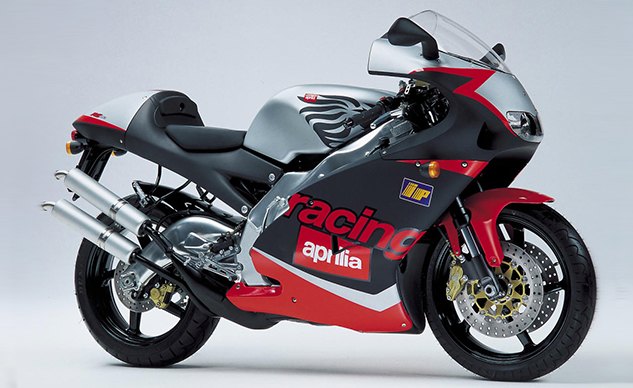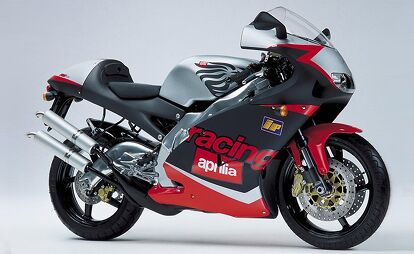Why Are Modern Swingarms Curved?
Is that a banana on your bike, or just happy to see us?
Dear MOby,
I have a question on swingarms. On my first bikes, the swingarms were straight. In fact, the “arms” were made out of rectangular steel tubes. But on the newer bikes I’ve owned, the swingarms have a “banana” shape that curves up in the middle. The curved swingarms also have a radius on the outward side, but I assume that’s to add strength to the structure.
Why are many modern swingarms curved instead of straight?
Thanks!
Kenneth Moore
Hmmmm, the first curvy banana swingarm I recall on a production bike was the one that came on the very tasty Aprilia RS250 of 1996 (which we conveniently just ran as a Church of MO). Being a two-stroke, the Aprilia needed room for its expansion chamber exhaust, and bending the swingarm upward that way provided it. But Aprilia didn’t invent that, as Kevin Schwantz’s RG500 racer had used a similar design before the Aprilia – and probably other bikes I’ve forgotten, too.
The swingarm on Schwantz’s bike looks like it may have been built at great cost by old-world craftsmen in some secret, dank Suzuki skunkworks. By the time Aprilia added that polished one to its expensive but not-ridiculously-so mass-produced RS250 a few years later, they’d figured out how to manufacture them.
Yamaha gets credit for being the first big manufacturer to use the technology that now makes possible all kinds of interesting shapes – vacuum die casting. Before it, swingarms were made up of extruded metal bars, like the aluminum swingarm on the 2002 R6 below.
For 2003, an all-new R6 was the first bike to use what Yamaha called Controlled Fill casting, which was responsible for the swingarm shape (and the whole frame) of the new bike. Suddenly parts of the motorcycle are organic metal sculpture – even if it’s hard to seen in the photo below since the new frame/swingarm are black.
Controlled Fill casting is what Yamaha calls vacuum casting – a process in which molten aluminum is sucked into the die instead of just poured into it. That process makes the casting much less porous, ensures the aluminum flows throughout the mold, and results in stronger, lighter pieces that can be nearly any shape the designer desires.
Yamaha’s Dr. Hiroshi Yamagata tells us all about it here:
“With the CF technology we can produce cast parts much lighter and at the same time even stiffer than with conventional casting. We can control the thickness of the material and adjust it accordingly in different areas of the cast part. So we can have strength were we structurally need it and save weight in areas where we have a lower stress factor. Also we can shape the parts freely and as another advantage the surface of the parts has a high quality.. We are also able to weld these cast part effectively, as you can see on the R6 swing-arm, consisting of two cast parts vertically split.
“The principle of the CF Aluminium Die Casting Technology is optimizing the conditions under which the hot aluminum flows into the mold. The objective is to make the molten aluminum fill the mold as effectively as possible so that it is evenly distributed in the mold before solidification begins. It allows us to produce thinner cast aluminum parts than previously yet still strong enough to be welded.
“The CF (Controlled Filling) method employs precise control of the casting conditions, involving (1) an exclusively developed seal material between the two halves of the mold in order to create a more complete vacuum (six times more complete than conventional method) within the mold and thus reduce air resistance as the molten aluminum enters, (2) controlling the temperature of the mold so that the temperature of the molten aluminium remains more stable and (3) increasing the speed with which the molten aluminium is injected into the mold (five times faster) so that ideal mold filling occurs.
The result is a cast aluminum with one-fifth of oxide-content compared to conventional die-cast aluminum, which makes the material easy to weld and although thin, the parts have a high rigidity.”
Since that vacuum-casting tech debuted on the R6 fifteen years ago, nearly all the manufacturers have adapted it to create all kinds of strong, beautiful and light aluminum components. How long till they’re all replaced by carbon fiber pieces like the ones on the BMW HP4 Race?
Send your moto-related questions to AskMOAnything@motorcycle.com. If we can’t answer them, we’ll at least do no harm in the time it takes to seek out a believable answer. And we’ll occasionally even admit we were wrong, even if we were right at the time. Depends on what the definition of “is” is.
Recent Ask MOs:
Should I Not Buy A Z900RS Because Of “Throttle Abruptness”?
Is ABS Worth and Extra 600 Bucks?
What the Heck are Centramatic Wheel Balancers?
More by John Burns






































Comments
Join the conversation
Thanks for the response , Mr. Burns . And thanks to you commentors who added additionaltechnical details. EcoMouse in particular.
What a load of pseudo scientific bollocks from you commenters. Bent swing arms are for clearance only. Anything else mentioned, "stiffness tuning" etc. can be achieved just as easily with a straight swing arm. Curves are invaluable in static structures where both ends are restrained, but a swingarm is, essentially a cantilever.
As for increasing downforce: as a wise man once (nearly) said, "Everyone in this room is now dumber for having read this".
"....and may God have mercy on your souls."